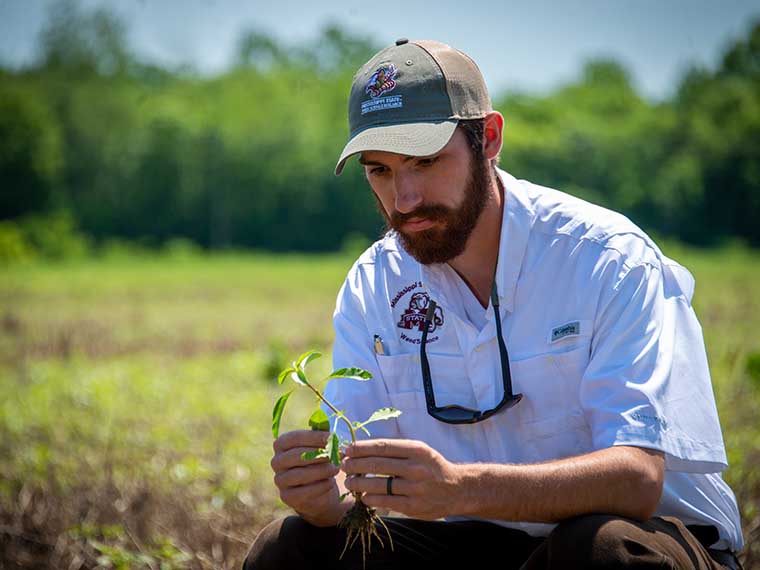The information presented on this page may be dated. It may refer to situations which have changed or people who are no longer affiliated with the university. It is archived as part of Mississippi State University's history.
Star City, Arkansas native Justin Calhoun grew up around row crop and livestock production agriculture. His background and passion for agriculture laid the perfect path for research to help farmers as a weed science graduate student at Mississippi State University.
When working in the field, it occurred to Calhoun that there is a significant void in weed control from late-August to mid-October, which typically marks the first frost.
"There is a gap in weed control where we don't have a crop in the field and we are not managing weed populations during that time," Calhoun said. "There are several different methods that can be used to control weeds during this period, but we really don't want to put a lot of pressure on herbicide use because of the potential for weed populations to become resistant to herbicides," Calhoun explained.
Under the guidance of Dr. Dan Reynolds, plant and soil sciences professor and Edgar E. and Winifred B. Hartwig Endowed Chair in Soybean Agronomy, Calhoun researched an alternative, unique method of weed control-cover crops.
"We investigated different ways to plant cover crops to facilitate weed suppression during that gap in weed control from August to October," Calhoun explained.
He researched how the use of cover crops impacted amaranth weed growth, specifically waterhemp growth, in soybean fields.
"We did find that we could interseed some cover crop species, specifically cereal rye, into a soybean canopy. We found that if we could get a cover crop established under that soybean canopy, once we harvested the soybeans, the cover crop would continue to grow and cover the ground, and, in turn, that provided weed suppression."
The research extends past weed control alone by making another viable case for the widespread use of cover crops in this region, which has not yet been adopted significantly by producers. With further research to refine the results, the argument for the usage of cover crops will be a strong force in the weed control realm, Calhoun added.
"There has been a lot of research in the Mississippi Agricultural and Forestry Experiment Station on cover crops in other arenas, such as soil health benefits, but producers are not readily adopting a cover crop system. Overall, as agronomists and producers, this research provides another explanation of how cover crops can potentially be used for weed suppression, as well. The more justifications we make for cover crops, the more likely we are to eventually see that management strategy widely accepted and adopted," Calhoun explained.
Calhoun will receive his master's in August 2019 and will pursue a doctoral degree in weed science at MSU. He will still focus on amaranth species weed control, but he will shift his focus from soybean to cotton production. Calhoun said he has developed a strong passion for research and hopes to continue to aid producers, with an eye on extension work.
Calhoun's research is funded by the Mississippi Soybean Promotion Board (MSPB). The MSPB works to fund innovative and impactful research for producers in the soybean industry.
"I think Mississippi has a very strong soybean promotion board. They do an excellent job working with universities to provide funding for research," Calhoun said.
This research is supported by the Mississippi Soybean Promotion Board.

